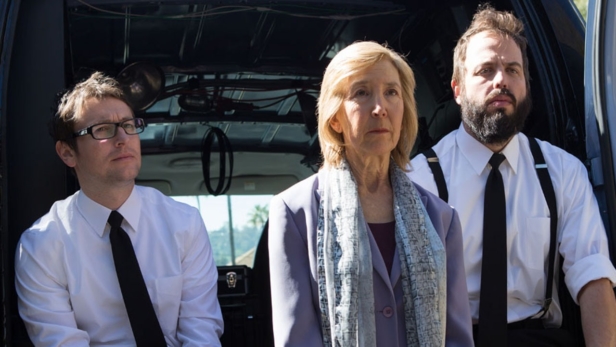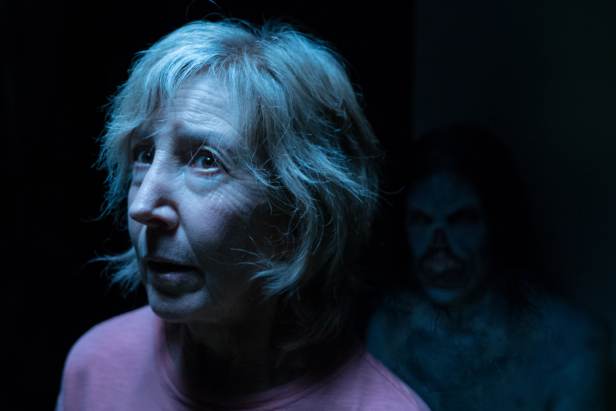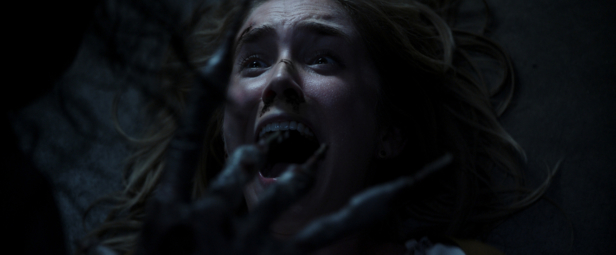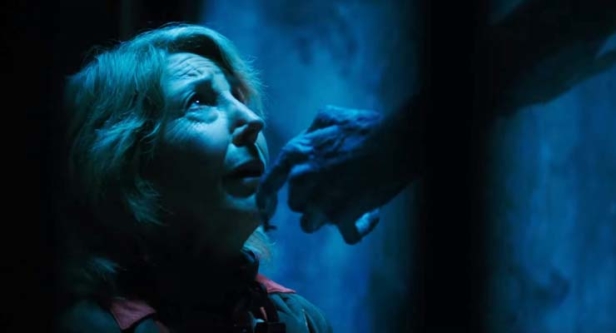After an incredible opening weekend at the US box-office, Insidious: The Last Key hits UK cinemas today, bringing Lin Shaye’s ghost hunter Elise Rainier back home for the most personal round of horrors yet.
Elise has moved from scene-stealer to lead character over the course of the four movies, giving them an emotional core that makes the deeply creepy scares lying in the Further hit that much harder. The importance of the character and the excellence of Lin Shaye is very much understood by series writer and Saw co-creator Leigh Whannell, who tells us that The Last Key puts Elise front and centre.
“It’s about going back to her hometown, back to her roots, and investigating a haunting in her childhood home,” he explains.
It must be set after 3 but before 1, then?
Yes! Yes, you’re right, it’s set after 3.
So you’ve written all the Insidious movies, since the first one. Can you tell me about how you developed the mythology of the Further?
Well, that came about in the first movie really. It was an idea that I’d had for a while. I met James Wan in film school, and when we finished film school we vowed to make a film together, but pretty quickly we discovered that films take money and we didn’t have any.
So we spent a few years knocking around Melbourne doing odd jobs, working at different production companies and generally being angsty miserable early-20s people. And we decided if we were ever going to make a film we had to produce our own money, and given that we had none we knew it had to be cheap. So there was a period of at least a year when we were trying to come up with a film we could shoot very cheaply, meaning it was all set in one room, with two or three actors at best, and funnily enough it’s very hard to come up with a film with those restrictions in place! I mean, every variation of a one-room film we could think of, we thought of and then discarded. We even had one idea that was entirely set in an elevator that was stuck… [laughs]
It took us a long time to hit upon the idea for Saw, which obviously was what we went with, but along the way one of the ideas I had was the basic idea for Insidious, about somebody’s astral body leaving their physical body while they were asleep and not returning and we kinda stored it away and didn’t really do anything with it.
Then, many years later when we were trying to come up with another film to do together, I went back to that idea and it kind of just struck me as something I hadn’t seen before. I basically wanted to see the world from a ghost’s perspective – like, what does the plane that ghosts live on look like? If you think about a haunted house movie, the ghosts or spirits that appear in the house appear and disappear, they’re not just sitting in the corner drinking tea and hanging out, they’re not raiding the cupboard for snacks, they’re there and then they’re not there. So that made me think that they exist on some other plane. It’s the same dimensional space, they’re still in your house, but it’s a different version of your house, and that’s what led to the Further.
At the time I didn’t think we’d be doing sequels – I never do, I’m just concentrating on the first movie, but as the sequels came out I’ve tried to explore the mythology and the idea of the Further a little more.
It’s kind of great, because it lets you have different antagonists; lets you pick different beings that exist in that dimension and make them the villain of the next film.
Yeah, exactly! Yeah, I mean, it’s this huge space, this void. I like to think of it as the negative space of the world, like a photograph: you have the white space and then you have all that black. So the Further is the negative version of our world, and in it exists all the tortured figures that have died or been murdered throughout history. Anybody who’s either been the victim of or committed a violent act is relegated to this realm and is just kind of wandering; they’re lost, they can’t find their way out.
And I didn’t even want to place it in terms of heaven and hell; there’s no religious context for it, I really just see it as this pace where spirits that can’t move on exist.
That’s a really good point – a lot of films that deal with exorcism obviously have a religious basis, but now that you mention it, there isn’t any religion referred to in the Insidious movies.
Nah yeah, that’s just not a direction I wanted to go in. We have seen that before whether it’s in The Exorcist or many other films like that: the old trope is to pull out a Bible and ward off the demon with a cross and holy water and I didn’t want to go down that path. I wanted to make it more metaphysical. Even the idea of astral projection, what that means, having an astral form that can float around, that was much more interesting to me than a traditional heaven/hell Judeo-Christian view of demons. I wanted to do something more, if not scientific, a little more metaphysical.
And you’ve got Lin Shaye at the centre of it all, tell me about working with her.
Lin’s fantastic, she’s a firecracker! She has more energy than most teenagers I know. She’s just so full of emotion and kind of zest for life that she’s a joy to be around when you’re not shooting but she’s also great when you are shooting because she’s able to access human emotions very quickly. She doesn’t need hours of warm up time to be sad about something; all of her memories and her emotions are very close to the surface, and if you’ve ever met her you’d agree! She’s very generous with that, she goes to difficult places and works herself up into states of real terror and you know, sadness, she really goes there, and it’s great to have her.
Now she’s really the centrepiece of the film. She’s graduated from a supporting player in the first film to a slightly bigger role in the second film, and in the third film she was sharing the lead with Stefanie Scott. And now in this fourth movie, she’s the star – there’s no doubting she’s number one on the call sheet, as they say! The movie is not only starring her but it’s about her and her past, delving into who she was as a little girl and where she came from.
If you’d thought about sequels from the beginning, do you think you might not have killed Elise off at the end of the first film?
[laughs]
I seem to have a problem with doing that! The same thing happened with Saw, I killed the character of Jigsaw off in the third movie and thought, ‘that’s it, trilogy over!’ And then the producers said they were going to make four more movies so I created a real migraine for them! Luckily it was one I didn’t have to deal with myself.
But I always go into these movies not only not thinking about sequels, but wondering if the script I’ve written will even get made. It’s like the opposite of thinking about a sequel, it’s thinking there won’t even be an original film. Even to this day, every time I write a script, the first question is, will this get made? The film economy, especially here in Los Angeles, is getting harder and harder to penetrate, it’s a very fractured media landscape at the moment if you take into account all the services like Netflix and YouTube, you’re competing for eyeballs across so many different platforms, and a lot of kids today would rather sit and watch YouTube than sit and watch a movie. It almost sounds archaic to think of a movie, paying money for a ticket and then sitting in a theatre! I’m hoping it doesn’t get to the point where it’s a totally archaic concept that’s relegated to a museum like ‘here’s a movie theatre! People used to do this!’ There’ll be a bunch of kids with their hologram helmets on saying ‘a movie what? You had to go somewhere and sit in a seat? That sounds stupid!’
And so I find it is getting more difficult to get films off the ground and the money is in shorter supply and the sorts of films that producers are willing to make is getting narrower. It seems to be nowadays it’s either The Avengers or it’s a low budget horror movie, but a lot of things that sat between those two bookends have been pushed aside to, you know, the void of VOD! You have to exist somewhere on iTunes so I’m about to start working on another script now and I’m hoping I can write something good enough just to get it made.
We’re talking about writing predominantly here but you act, too, and you directed Insidious 3, so do you still think of yourself as a writer, first?
I kind of do. It’s an interesting question. When I met James Wan, in film school, he was so dedicated to one thing – he wanted to be a director and that’s all he wanted to do and he was on this one track path to that goal. Whereas I felt a little more spread around the map – some days I felt like I wanted to perform and be an actor, other days I liked writing, but then I was making films in film school and directing. So I was scattered in that way, but I have to say recently I’ve fallen in love with directing. And if I had to name my favourite discipline, it would be directing. I really love that process of standing on a set and making things happen, and kind of corralling these disparate talents into one room, herding them all to one goal. And trying to convince other people to interpret something the way I see it! I just love that. But ‘screenwriter’ is still what I write on the visa forms.

You directed another film recently, right? What can you tell me about Stem?
Yeah, I directed a sci-fi film this year in Melbourne, currently called Stem, I say currently because you never know if they’re gonna change but I had so much fun directing it and I can’t wait for people to see it.
It’s set in the very near future and it’s essentially about a technophobe who’s living a little out of his time. Everything’s become automated and virtual, and he’s this very analogue guy who still fixes up old cars and hates virtual reality. So he exists in this world and then he and his wife are carjacked, and he’s injured so badly he’s quadriplegic. So suddenly this guy who’s avoided technology his whole life is totally reliant on it to get around and to be fed, and he ends up getting implants with these experimental computer chip that controls his body for him… but it turns out the chip can help him track down these guys who shot him and his wife. So it’s this sci-fi thriller that’s really influenced by the films of David Cronenberg and Paul Verhoeven, and I’ve tried to do everything practically and barely used CG – of course, there are times you have to rely on CGI to fill in the corners of the frame but I’ve tried to do as much practically as possible.
[final question klaxon]
This is gonna seem like an odd question, but I have to ask, how did you get involved with The Bye Bye Man?
That was just an offer! A director that I’d met before, Stacy Title, who’s a lovely person, she just offered me to come in and do a cameo in the opening scene so I thought, why not? You know, I’ve been writing and directing so much I don’t get asked to the dance very often as an actor so if I do I usually accept. And I thought it’d be fun to go in and do a cameo for a couple of days where I get to kill a bunch of people and it was really fun.
It was all shot in one day and it is interesting once you get to a film set you realise they can only fake so much. You’re not actually killing people, but you are holding a real shotgun and you are really firing it! It’s pretty nerve-racking when some guy who fires guns for a living and knows all about them hands one to somebody who’s barely even seen a gun and is like ‘now you need to walk into that room with total confidence and just kill everybody.’ It was not a bad way to spend a Tuesday in Cleveland.
Insidious: The Last Key is in UK cinemas today. Keep up with the latest horror news with the new issue of SciFiNow.


